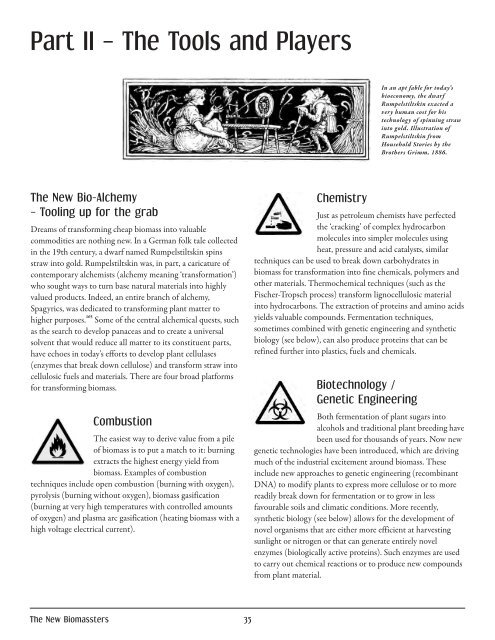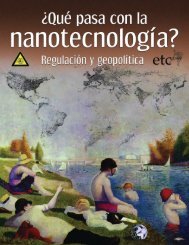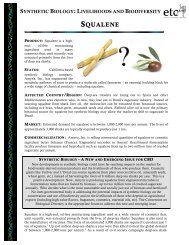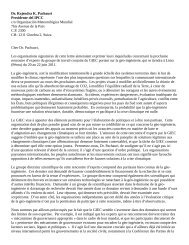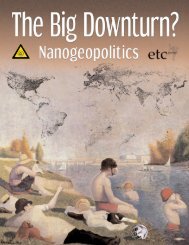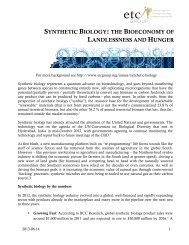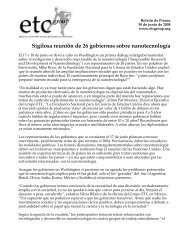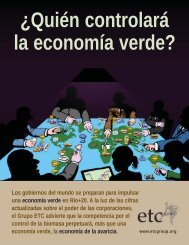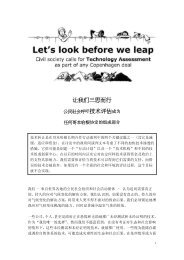The New Biomassters - Convention on Biological Diversity
The New Biomassters - Convention on Biological Diversity
The New Biomassters - Convention on Biological Diversity
You also want an ePaper? Increase the reach of your titles
YUMPU automatically turns print PDFs into web optimized ePapers that Google loves.
Part II – <str<strong>on</strong>g>The</str<strong>on</strong>g> Tools and Players<br />
In an apt fable for today’s<br />
bioec<strong>on</strong>omy, the dwarf<br />
Rumpelstiltskin exacted a<br />
very human cost for his<br />
technology of spinning straw<br />
into gold. Illustrati<strong>on</strong> of<br />
Rumpelstiltskin from<br />
Household Stories by the<br />
Brothers Grimm, 1886.<br />
<str<strong>on</strong>g>The</str<strong>on</strong>g> <str<strong>on</strong>g>New</str<strong>on</strong>g> Bio-Alchemy<br />
– Tooling up for the grab<br />
Dreams of transforming cheap biomass into valuable<br />
commodities are nothing new. In a German folk tale collected<br />
in the 19th century, a dwarf named Rumpelstiltskin spins<br />
straw into gold. Rumpelstiltskin was, in part, a caricature of<br />
c<strong>on</strong>temporary alchemists (alchemy meaning ‘transformati<strong>on</strong>’)<br />
who sought ways to turn base natural materials into highly<br />
valued products. Indeed, an entire branch of alchemy,<br />
Spagyrics, was dedicated to transforming plant matter to<br />
higher purposes. 165 Some of the central alchemical quests, such<br />
as the search to develop panaceas and to create a universal<br />
solvent that would reduce all matter to its c<strong>on</strong>stituent parts,<br />
have echoes in today’s efforts to develop plant cellulases<br />
(enzymes that break down cellulose) and transform straw into<br />
cellulosic fuels and materials. <str<strong>on</strong>g>The</str<strong>on</strong>g>re are four broad platforms<br />
for transforming biomass.<br />
Combusti<strong>on</strong><br />
<str<strong>on</strong>g>The</str<strong>on</strong>g> easiest way to derive value from a pile<br />
of biomass is to put a match to it: burning<br />
extracts the highest energy yield from<br />
biomass. Examples of combusti<strong>on</strong><br />
techniques include open combusti<strong>on</strong> (burning with oxygen),<br />
pyrolysis (burning without oxygen), biomass gasificati<strong>on</strong><br />
(burning at very high temperatures with c<strong>on</strong>trolled amounts<br />
of oxygen) and plasma arc gasificati<strong>on</strong> (heating biomass with a<br />
high voltage electrical current).<br />
Chemistry<br />
Just as petroleum chemists have perfected<br />
the ‘cracking’ of complex hydrocarb<strong>on</strong><br />
molecules into simpler molecules using<br />
heat, pressure and acid catalysts, similar<br />
techniques can be used to break down carbohydrates in<br />
biomass for transformati<strong>on</strong> into fine chemicals, polymers and<br />
other materials. <str<strong>on</strong>g>The</str<strong>on</strong>g>rmochemical techniques (such as the<br />
Fischer-Tropsch process) transform lignocellulosic material<br />
into hydrocarb<strong>on</strong>s. <str<strong>on</strong>g>The</str<strong>on</strong>g> extracti<strong>on</strong> of proteins and amino acids<br />
yields valuable compounds. Fermentati<strong>on</strong> techniques,<br />
sometimes combined with genetic engineering and synthetic<br />
biology (see below), can also produce proteins that can be<br />
refined further into plastics, fuels and chemicals.<br />
Biotechnology /<br />
Genetic Engineering<br />
Both fermentati<strong>on</strong> of plant sugars into<br />
alcohols and traditi<strong>on</strong>al plant breeding have<br />
been used for thousands of years. Now new<br />
genetic technologies have been introduced, which are driving<br />
much of the industrial excitement around biomass. <str<strong>on</strong>g>The</str<strong>on</strong>g>se<br />
include new approaches to genetic engineering (recombinant<br />
DNA) to modify plants to express more cellulose or to more<br />
readily break down for fermentati<strong>on</strong> or to grow in less<br />
favourable soils and climatic c<strong>on</strong>diti<strong>on</strong>s. More recently,<br />
synthetic biology (see below) allows for the development of<br />
novel organisms that are either more efficient at harvesting<br />
sunlight or nitrogen or that can generate entirely novel<br />
enzymes (biologically active proteins). Such enzymes are used<br />
to carry out chemical reacti<strong>on</strong>s or to produce new compounds<br />
from plant material.<br />
<str<strong>on</strong>g>The</str<strong>on</strong>g> <str<strong>on</strong>g>New</str<strong>on</strong>g> <str<strong>on</strong>g>Biomassters</str<strong>on</strong>g> 35


